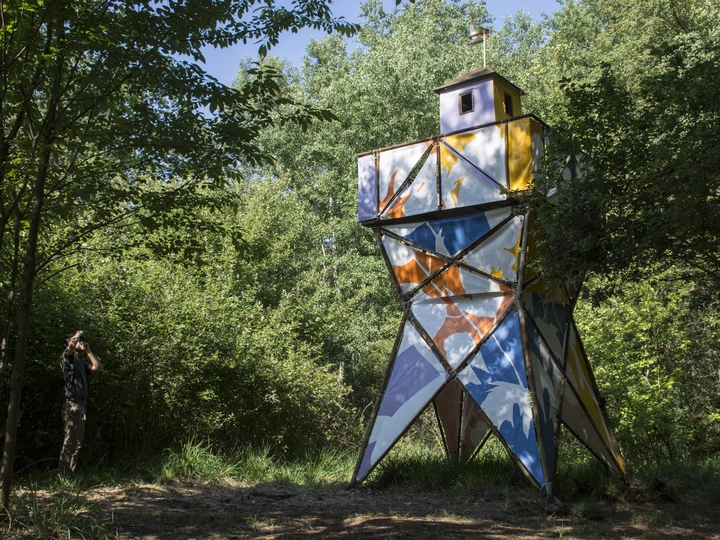Anti-camouflage

Oliviero Fiorenzi
Oliviero Fiorenzi (b.1992, Osimo) lives and works between Milan and Osimo. Growing up between these two contexts, he developed a particular sensitivity for the theme of landscape. Careful of the variables present in the field in which he operates, the artist expands his graphic and pictorial research drawing on the imaginary developed during the years of childhood and adolescence. This is the time where we discover the world through the forms of play, and it's precisely through these experiences, lived and then methodically remembered, that Fiorenzi develops his personal mythology: a constantly updated visual alphabet; an instrument through which, depending on the project, he creates new architectures of meaning.
The military watchtower’s purpose is to create a protected vantage point, to see while being unseen. The verticality of the tower is born of the necessity to extend the eyesight.
From stooping animal to vertical animals, humans stood up to surive. With a vertical push, sight gained its primacy in the hierarchy of senses, becoming the most stimulated and alert. For this reason it has always been strategically important to see and possibly not be seen.
Placed at the edge of a significant geographical space, the tower allowed to anticipate danger for the single or the community. Today that verticality has reached its apex through Unmanned Aerial Vehicles and satellites, and watchtowers stand useless and forgotten.
My intervention aimed at subverting the tower's purposes of control and protection, while also highlighting the presence of an abandoned collective memory. I tailored cuts of cotton canvas on the tower’s structure, and then painted them in a color palette in contrast with the environment, with patterns taken from local flora, thus creating an anti-camouflage. By dressing the tower with the canvas, I made it into a clearly visible landmark, whereas before it was hidden in the overgrowth. The fabric also covered the sighting platform of the tower, making it blind and completely useless as a vantage point.
The intervention took place in the Groane Park, an area which hosted an important weapon deposit from 1914 to the end of WWII. After an Allied bombing in 1944 spread explosive munitions all around the grounds of the deposit, it had to be forcibly abandoned. In the following decades, nature advanced undisturbed and covered everything, hiding the military structures among luxuriant vegetation. Bomb craters became ponds as unexploded ordnance deterred anyone from trespassing. Thus the park was born.
The anti-camouflage, by covering up the abandoned building, brings it to the forefront, making it impossible to ignore it and hide it from one’s history.